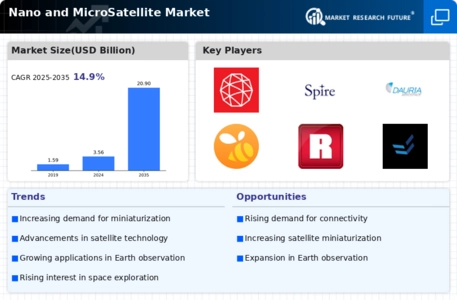Growing Demand for Earth Observation
The Global Nano and Microsatellite Industry experiences a surge in demand for earth observation applications. Governments and private entities increasingly rely on satellite data for environmental monitoring, agriculture, and disaster management. For instance, the European Space Agency utilizes small satellites for monitoring climate change and natural disasters. This trend is expected to drive the market's growth, with the industry projected to reach 3.56 USD Billion in 2024. The increasing need for timely and accurate data suggests that the demand for nano and microsatellites will continue to rise, potentially leading to a market expansion as stakeholders seek innovative solutions.
Chart Representation of Market Growth
The Global Nano and Microsatellite Industry exhibits a compelling growth trajectory, as illustrated in the accompanying charts. The market is projected to reach 3.56 USD Billion in 2024, with a remarkable increase to 20.9 USD Billion by 2035. The compound annual growth rate of 17.46% from 2025 to 2035 highlights the industry's potential for expansion. These visual representations underscore the dynamic nature of the market, reflecting the interplay of technological advancements, investment trends, and emerging applications that are shaping the future of nano and microsatellites.
Increased Investment in Space Programs
The Global Nano and Microsatellite Industry benefits from increased investment in space programs by both government and private sectors. Countries are recognizing the strategic importance of space capabilities, leading to enhanced funding for satellite development. For instance, the United States has allocated substantial budgets for small satellite initiatives, fostering innovation and collaboration among industry players. This influx of capital is likely to stimulate market growth, as new projects emerge and existing programs expand. The anticipated compound annual growth rate of 17.46% from 2025 to 2035 indicates a robust investment climate, further propelling the industry's expansion.
Advancements in Miniaturization Technology
Technological advancements in miniaturization are pivotal to the Global Nano and Microsatellite Industry. Innovations in materials and manufacturing processes enable the development of smaller, lighter, and more efficient satellites. For example, the use of 3D printing has revolutionized satellite design, allowing for rapid prototyping and reduced costs. These advancements not only enhance satellite capabilities but also lower launch costs, making space more accessible. As a result, the market is likely to witness significant growth, with projections indicating a market size of 20.9 USD Billion by 2035. This trend underscores the importance of technological evolution in driving market dynamics.
Emerging Applications in Telecommunications
Emerging applications in telecommunications are reshaping the Global Nano and Microsatellite Industry. Small satellites are increasingly utilized for providing internet connectivity in remote areas, bridging the digital divide. Companies like SpaceX are deploying constellations of small satellites to deliver broadband services globally. This trend is indicative of a broader shift towards utilizing nano and Microsatellite for commercial purposes, enhancing their market appeal. As demand for global connectivity rises, the market is poised for growth, with projections suggesting a substantial increase in market size over the next decade, driven by the need for innovative communication solutions.

















Leave a Comment